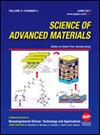煅烧温度对纳米TiO2/硅藻土复合光催化剂表面酸性和光催化活性的影响
IF 0.9
4区 材料科学
引用次数: 0
摘要
采用水解-沉积法制备了纳米TiO2/硅藻土复合光催化剂。通过X射线衍射、N2吸附/脱附、Fransmission电子显微镜、傅立叶变换红外光谱、X射线光电子能谱、吡啶原位吸附傅立叶变换红外以及甲醛在空气中的吸附和光降解,研究了煅烧温度对光催化剂表面酸性和光催化活性的影响。结果表明,高温和二氧化钛的成核都会消耗表面的Brönsted酸位,并随着Ti–O–Si键的形成形成表面路易斯酸。在室温下,在600°C下煅烧的复合材料在紫外线照射下表现出最高的甲醛分解率。本文章由计算机程序翻译,如有差异,请以英文原文为准。
Effect of Calcination Temperature on Surface Acidity and Photocatalytic Activity of Nano-TiO2/Diatomite Composite Photocatalyst
Nano-TiO2/diatomite composite photocatalysts were prepared by hydrolysis-deposition method in the present study. The effect of calcination temperature on surface acidity and photocatalytic activity of the photocatalysts was characterized by X-ray diffraction, N2
adsorption/desorption, Fransmission electron microscope, Fourier transform infrared, X-ray photoelectron spectroscopy, pyridine adsorption in situ fourier transform infrared and the adsorption and photodegradation of formaldehyde in air. Results revealed that the high temperature and
the nucleation of titanium dioxide both can consume the surface Brönsted acid sites, and with the formation of Ti–O–Si bond to form surface Lewis acid. The composite calcined at 600 °C presents the highest decomposition of formaldehyde under UV irradiation at the room
temperature.
求助全文
通过发布文献求助,成功后即可免费获取论文全文。
去求助
来源期刊

Science of Advanced Materials
NANOSCIENCE & NANOTECHNOLOGY-MATERIALS SCIENCE, MULTIDISCIPLINARY
自引率
11.10%
发文量
98
审稿时长
4.4 months
 求助内容:
求助内容: 应助结果提醒方式:
应助结果提醒方式:


